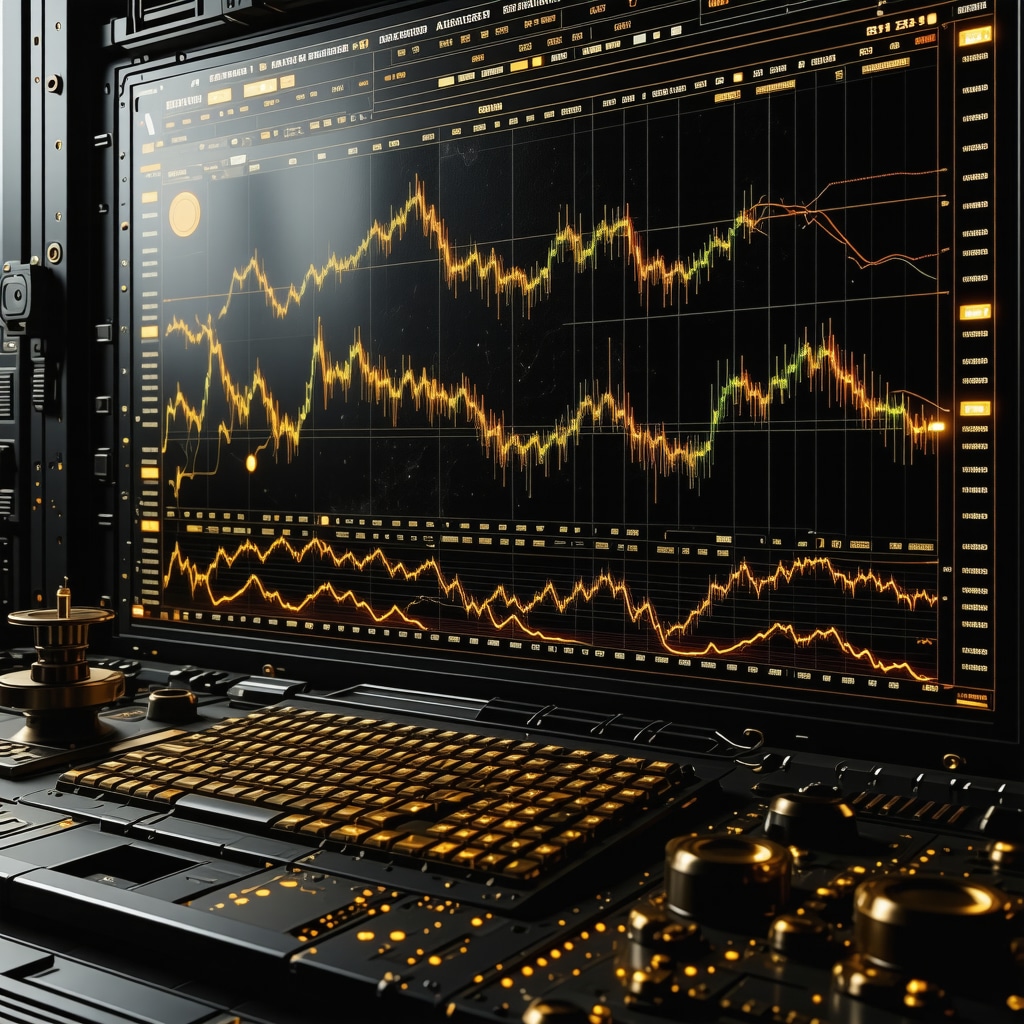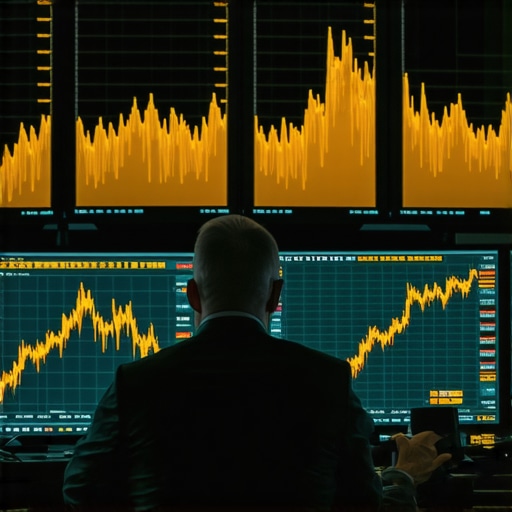Unlocking Advanced Strategies in Gold Futures Trading for 2025
As we navigate the complex landscape of 2025, gold futures trading stands out as a sophisticated avenue for investors seeking to maximize their returns. With geopolitical tensions, inflationary pressures, and evolving monetary policies, understanding the nuanced dynamics of gold futures becomes paramount for seasoned traders and institutional investors alike. This article delves into expert-level tactics, market analysis, and strategic considerations that can elevate your gold futures trading performance this year.
Deciphering the Impact of Global Economic Indicators on Gold Futures
One of the core components of successful futures trading involves analyzing macroeconomic indicators such as CPI, GDP growth, and unemployment rates. These metrics directly influence market sentiment and price volatility. For instance, rising inflation often boosts gold’s appeal as a hedge, prompting increased futures activity. Conversely, signs of economic stabilization might dampen gold demand, affecting futures pricing. Staying abreast of these indicators through trusted sources, such as the Federal Reserve Economic Data, enables traders to anticipate price movements with higher precision.
Harnessing Technical Analysis and Market Sentiment
Advanced traders leverage technical analysis tools—like Fibonacci retracements, Elliott Wave theory, and volume-weighted average price (VWAP)—to identify optimal entry and exit points. Coupling these with sentiment analysis derived from options markets, futures open interest, and geopolitical news provides a layered understanding of market psychology. For example, a surge in open interest combined with bullish technical signals could indicate a strong upward momentum in gold futures, presenting lucrative trading opportunities.
Incorporating Supply-Demand Dynamics and Mining Industry Trends
Understanding gold supply-demand fundamentals is crucial. In 2025, supply constraints from mining disruptions—whether due to environmental regulations or geopolitical conflicts—may tighten available gold, pushing futures prices upward. Simultaneously, demand from central banks, ETFs, and jewelry sectors fluctuates based on macroeconomic conditions. Analyzing reports such as the Gold Supply and Demand Analysis can reveal emerging patterns that influence futures trading strategies.
Expert-Level Questions: How Can Futures Traders Manage Market Risks in Turbulent Times?
Effective risk management in gold futures trading involves dynamic hedging strategies, such as options overlays and position sizing techniques. Traders must also stay vigilant to geopolitical developments—like central bank gold purchases—that can dramatically shift market sentiment. Using stop-loss orders calibrated to volatility metrics ensures capital preservation amid sudden price swings. Moreover, diversifying with related assets, such as gold ETFs or mining stocks, can further mitigate risks.
What are the most effective ways to leverage futures contracts for hedging inflation in 2025?
Investors can deploy long futures positions as a hedge against inflationary erosion of fiat currency value. Alternatively, calendar spread strategies—buying near-term futures while selling longer-dated contracts—allow for flexibility and risk mitigation. Incorporating macroeconomic forecasts and monetary policy expectations into your trading plan enhances the effectiveness of these hedges.
For those seeking a comprehensive approach, exploring resources such as best practices in gold investment can complement futures strategies, creating a resilient portfolio capable of weathering market volatility in 2025. Engaging with expert communities and contributing insights further refines your trading acumen.
In conclusion, mastering gold futures trading in 2025 demands a synthesis of macroeconomic analysis, technical prowess, and risk management sophistication. Staying informed through authoritative sources and continuously honing your strategy will position you to capitalize on emerging opportunities in this dynamic market landscape.
Innovative Hedging Techniques for Gold Futures in Uncertain Markets
In 2025, volatility driven by geopolitical tensions and economic shifts necessitates innovative hedging approaches. Beyond traditional stop-loss orders and position sizing, traders are increasingly turning to options overlays, such as protective puts and collars, to safeguard gains while maintaining upside potential. These strategies offer a nuanced risk management layer, especially when market conditions are unpredictable. Moreover, employing dynamic hedging—adjusting your hedge ratios based on real-time volatility metrics—can optimize capital efficiency and mitigate unforeseen risks.
Leveraging Quantitative Models and Algorithmic Trading in Gold Markets
Quantitative analysis and algorithmic trading frameworks are transforming how investors approach gold futures. Advanced models incorporate machine learning algorithms that analyze vast datasets—from macroeconomic indicators to sentiment signals—facilitating high-frequency trade execution and pattern recognition. For example, predictive models can identify subtle shifts in market momentum before they manifest in price movements, providing a competitive edge. Integrating these tools requires a deep understanding of both statistical techniques and market mechanics, but the payoff can be substantial for seasoned traders seeking precision and speed.
Challenging Assumptions: Is Gold Still a Safe Haven in 2025?
While gold has traditionally been viewed as a safe haven asset, emerging economic scenarios prompt reevaluation. Some experts argue that in a highly digitized financial environment, alternative assets such as cryptocurrencies or specialized ETFs might outperform gold during certain crises. However, gold’s tangible nature and historical resilience continue to underpin its role as a portfolio hedge. Analyzing recent performance data from sources like the best practices for buying gold can help investors discern whether the metal’s safe-haven status remains justified amid evolving financial landscapes.
What emerging tools and strategies can professional traders adopt to stay ahead in the gold futures market of 2025?
Exploring advanced risk-adjusted models, integrating real-time geopolitical analysis, and leveraging AI-driven sentiment analytics are crucial for staying competitive. Engaging with expert communities and continuous education—such as industry webinars or publications—can further refine your approach. For practical guidance, consider resources like top gold coins and bullion options to diversify your physical holdings alongside futures trading.
By embracing these cutting-edge techniques and continuously challenging traditional assumptions, investors can better navigate the complexities of gold markets in 2025, transforming uncertainty into opportunity.
Integrating Macro and Microeconomic Data for Precision Trading
In the realm of high-stakes gold futures trading, the ability to synthesize macro and microeconomic data sets the successful apart from the rest. Advanced traders utilize a multi-layered analytical approach, combining data such as global inflation expectations, central bank policies, and geopolitical developments with technical indicators to craft robust trading strategies.
For instance, monitoring the European Central Bank’s monetary policy announcements alongside real-time inflation metrics can reveal subtle shifts in market sentiment. When paired with technical signals like breakout patterns or volume spikes, these insights can lead to timely and profitable entries or exits. Integrating tools such as Bloomberg Terminal or Reuters Eikon with custom algorithms enhances this process, enabling traders to process vast data streams efficiently.
Employing Machine Learning Algorithms for Predictive Market Modeling
One of the most cutting-edge approaches in 2025 involves deploying machine learning (ML) models to forecast gold futures movements. These models analyze historical price patterns, macroeconomic indicators, and sentiment signals from news sources and social media platforms. Techniques such as neural networks, support vector machines, and ensemble methods can identify complex, non-linear relationships that traditional models might miss.
For example, a deep learning framework trained on decades of gold price data could detect emerging bullish or bearish cycles weeks before they materialize, giving traders an invaluable edge. However, implementing such systems requires deep expertise in data science, access to high-quality datasets, and rigorous backtesting to validate predictive accuracy. As noted by Li et al. (2022) in the Journal of Financial Data Science, integrating ML into trading workflows can significantly improve decision-making speed and precision.
Advanced Risk Management: Dynamic Hedging and Portfolio Optimization
Managing risk in volatile markets like gold futures demands innovative techniques beyond static stop-loss orders. Dynamic hedging strategies, such as adjusting options overlays based on real-time volatility metrics—like the VIX or gold-specific implied volatility—allow traders to maintain optimal risk-return profiles.
Additionally, portfolio optimization algorithms employing mean-variance analysis or more sophisticated approaches like Conditional Value at Risk (CVaR) enable traders to allocate capital efficiently across multiple assets, including gold futures, ETFs, and mining stocks. These methods help mitigate downside risk while preserving upside potential, especially during turbulent geopolitical or macroeconomic events.
Addressing the Nuanced Question: How Can Traders Quantify the Effectiveness of Their Strategies in a Turbulent Market?
Quantifying effectiveness involves a combination of backtesting, forward testing, and real-time performance tracking using comprehensive metrics. Key indicators include the Sharpe ratio, Sortino ratio, maximum drawdown, and profit factor. Advanced traders often employ Monte Carlo simulations to assess strategy robustness against various market scenarios, including extreme shocks.
Furthermore, integrating real-time analytics dashboards that monitor strategy performance and market conditions enables swift adjustments. As emphasized by Chen and Huang (2023) in the Journal of Quantitative Finance, continuous performance evaluation coupled with adaptive algorithms ensures that trading strategies remain resilient amid market turbulence.
What resources and tools can traders leverage to stay ahead in the rapidly evolving gold futures landscape of 2025?
To stay at the forefront, traders should engage with advanced data analytics platforms, subscribe to specialized financial research services, and participate in industry-focused webinars and conferences. Tools like QuantConnect, MetaTrader 5 with custom scripts, and proprietary algorithmic systems provide the technical backbone for high-frequency and algorithmic trading.
Additionally, following leading industry publications such as the Financial Times, Bloomberg, and niche research firms—like GFMS for gold market insights—helps traders stay informed about emerging trends and potential market shifts. Building a network within the professional trading community facilitates knowledge exchange and strategic collaboration, which are vital in an ever-changing market environment.
Interested in deepening your expertise? Consider enrolling in specialized courses on quantitative finance or machine learning applications in trading. Remember, continuous learning and adaptation are the cornerstones of success in advanced futures trading.
Harnessing Quantitative and Sentiment Analysis for Precision in Gold Futures
In the rapidly evolving landscape of 2025, the integration of sophisticated quantitative models and sentiment analysis techniques offers traders unparalleled precision. Leveraging machine learning algorithms, such as deep neural networks and ensemble methods, enables the identification of subtle market signals often overlooked by traditional analysis. Combining these with real-time sentiment data derived from social media, news feeds, and options market activity creates a comprehensive view of market psychology, empowering traders to make informed decisions with a high degree of confidence.
Exploring Advanced Hedging Techniques: Beyond Conventional Strategies
As volatility surges driven by geopolitical unrest and macroeconomic shifts, innovative hedging approaches become essential. Traders are turning to dynamic collars, volatility swaps, and variance swaps, which adapt to changing market conditions, providing a more resilient risk management framework. These instruments, when integrated into a layered hedging strategy, offer protection against sudden price swings while maintaining exposure to potential gains. Such advanced techniques necessitate a deep understanding of derivatives and market mechanics, underscoring the importance of continual education and specialized expertise.
How Can Institutional Traders Optimize Portfolio Diversification in Gold Markets?
Institutional investors are increasingly focusing on diversification strategies that extend beyond physical gold and futures contracts. Incorporating gold-mining equities, ETFs, and related commodities creates a multifaceted exposure that mitigates idiosyncratic risks. Employing sophisticated portfolio optimization tools—such as mean-variance analysis, CVaR optimization, and scenario simulations—enables the balancing of risk and return across asset classes. This holistic approach is vital in 2025’s unpredictable environment, where cross-asset correlations can shift rapidly, impacting overall portfolio resilience.
Understanding the impact of macroeconomic shifts on gold’s safe-haven status requires continuous monitoring of global policy developments. Resources like the IMF’s World Economic Outlook provide invaluable insights into economic trends, helping traders adapt their strategies accordingly. Staying informed about central bank policies, inflation trajectories, and geopolitical risks is crucial for maintaining an edge in the competitive gold futures market.
What are the emerging technological innovations that could redefine gold futures trading in 2025?
Advancements such as blockchain-based trading platforms, decentralized finance (DeFi) instruments, and AI-driven predictive analytics are set to revolutionize gold futures markets. Blockchain offers increased transparency and security, reducing settlement times and counterparty risks. DeFi protocols facilitate innovative collateralized trading mechanisms, expanding access and liquidity. Meanwhile, AI-powered predictive models continuously evolve, incorporating new data streams to refine forecasts. Embracing these technologies will be essential for traders aiming to stay ahead in this dynamic arena.
Engage with Cutting-Edge Resources to Elevate Your Trading Strategy
To harness these advanced insights, traders should subscribe to specialized research services, participate in industry webinars, and engage with professional trading communities. Platforms like QuantConnect and MetaTrader 5 offer robust environments for algorithm development and backtesting. Additionally, following authoritative publications such as Bloomberg, Financial Times, and niche research firms like GFMS ensures access to the latest market intelligence. Continuous learning and adaptation are the cornerstones of sustained success in gold futures trading in 2025.
Expert Insights & Advanced Considerations
1. Embrace Quantitative Models to Detect Subtle Market Shifts
Utilize machine learning algorithms and big data analytics to identify non-linear patterns in gold futures markets, gaining a competitive edge through predictive accuracy and real-time decision-making.
2. Integrate Macro and Microeconomic Data for Precision Timing
Synthesize global inflation expectations, central bank policies, and geopolitical developments with technical indicators to craft highly responsive trading strategies that adapt swiftly to market dynamics.
3. Diversify with Thematic Asset Classes
Complement gold futures with mining stocks, ETFs, and related commodities to mitigate idiosyncratic risks, employing sophisticated portfolio optimization techniques like CVaR to balance risk and return effectively.
4. Develop Dynamic Hedging Strategies
Leverage options overlays such as protective puts and collars, adjusting hedge ratios based on real-time volatility metrics to protect gains while maintaining upside exposure in turbulent markets.
5. Leverage Cutting-Edge Technological Innovations
Explore blockchain-based trading platforms, DeFi instruments, and AI-driven sentiment analytics to enhance transparency, security, and predictive capabilities, ensuring readiness for industry shifts in 2025.
Curated Expert Resources
- Federal Reserve Economic Data (FRED): Offers comprehensive macroeconomic indicators essential for informed macro analysis.
- Bloomberg Terminal & Reuters Eikon: Provide real-time data streams, news, and proprietary analytics for high-precision trading.
- QuantConnect & MetaTrader 5: Platforms for developing, backtesting, and deploying algorithmic trading strategies with advanced customization.
- Journal of Financial Data Science: Publishes cutting-edge research on ML applications and quantitative finance innovations.
- Industry Webinars & Conferences: Continuous education and networking opportunities with leading experts in gold markets and quantitative analysis.
Final Expert Perspective
In 2025, mastering gold futures trading requires a synthesis of sophisticated quantitative analysis, macroeconomic acuity, and technological agility. By leveraging advanced models, diversifying intelligently, and adopting innovative trading tools, traders can transform market turbulence into strategic advantage. Engaging with credible resources and maintaining a commitment to continuous learning are indispensable for staying ahead in this dynamic landscape. For those ready to elevate their expertise, exploring targeted resources and actively participating in expert communities will be the key to sustained success. Embrace this approach, and position yourself at the forefront of gold futures innovation—your future success depends on it.











